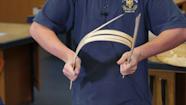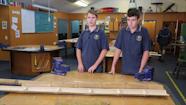Steve Andrew explains how understanding materials is essential for effective technological practice.
Combining knowledge and practice
Transcript
Our students come from a range of schools within the Waikato. There’s about 20 schools that are contributing schools to our college. Some of them have got technology background from their previous schools, but quite a few of them just come in with very little knowledge.
But I think it is really important to understand that you know the students, and I think it generally goes right across the country, that students entering secondary school are coming in with a very low technological literacy level, and we’ve got to be aware of that so that we know we can pick a really good starting point. And I don’t think we should be afraid to start at a low level. It gives us the awareness that the students have got that knowledge as we are moving on.
For a while now, the focus in technology has been on technological practice, but we’ve got these two new strands now that have been introduced to us and I find that the technological knowledge strand really supports the teaching that I’m trying to deliver to my students.
I focus on technological products, because I believe that the materials component in the products fits really well into what we’re doing. So when I talk to my students, I regularly have examples of products that we talk about the materials and the components and the way that they have been manipulated and that sort of thing.
I was once told, or once read an article, that 90% of product failure is due to materials failure or incorrect materials. And that kind of brought back to me how important materials were to our subject, and I think now that we’ve got that focus with the product strand it gives us some real depth to work on. Where I come from, from a trade background, you know materials and processing and manipulation and that just come naturally, and I think that that is what’s important to deliver to our students.
Related videos
Linking hands-on experiences and understandings (03:54)
Hands-on experiences allow the students to see materials understandings in action.
Play, experiment, explore (02:55)
Steve Andrew lets the students see, feel, and play with products to develop their understandings in materials.
Finding materials to meet the specs (02:36)
Steve Andrew shares how students identify material specifications in a brief and then test materials to find those that are suitable....
School–industry relationship cuts both ways (03:36)
Steve Andrew and Terry Rillstone describe the way the relationship between St John's College and The Shop has benefits for them both....
Pushing the boundaries with materials (02:53)
Steve Andrew describes how his senior students have the confidence to select and work with unfamiliar materials.
Exploring unfamiliar materials (02:44)
Year 12 students from St John's College describe what they know about bamboo and how they are applying this knowledge to their projects....
Students and teachers talk about testing materials in year 11.
Manipulating, forming, and transforming
Students in year 10 describe manipulating, forming, and transforming materials.
Evaluating materials for an outcome
Steve Andrew and students talk about using their knowledge to test materials for their projects at year 12.
Year 10 students describe some of the attributes for the snake skates they are developing.
Senior students select their own issues
Year 12 students talk about the issues that they have selected for their projects.











